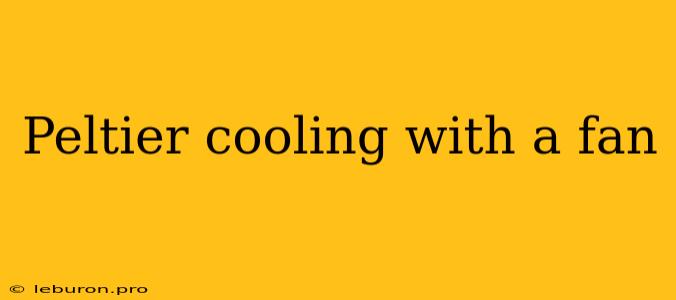Peltier cooling devices, also known as thermoelectric coolers, offer a unique and versatile approach to temperature control. They leverage the Peltier effect, a phenomenon where heat is transferred across an electrical junction when an electric current is applied. This principle enables Peltier coolers to effectively cool down electronic components, semiconductor lasers, and other heat-sensitive devices. However, to maximize their cooling efficiency and prevent overheating, integrating a fan with the Peltier device is crucial. This article delves into the synergy between Peltier cooling and fans, exploring their combined benefits and applications.
Understanding the Peltier Cooling Principle
At the heart of Peltier cooling lies the Peltier effect, a thermodynamic phenomenon observed in junctions between dissimilar electrical conductors. When an electric current flows through such a junction, heat is absorbed from one side and released on the other. This heat transfer is directly proportional to the current flowing through the junction. Peltier coolers typically consist of multiple semiconductor junctions arranged in a series, creating a thermoelectric module.
The cold side of the module absorbs heat from the object being cooled, while the hot side releases the absorbed heat into the surrounding environment. The effectiveness of the cooling process depends on factors such as the module's material, the applied current, and the temperature difference between the hot and cold sides. However, Peltier coolers have a limitation: they generate significant heat on the hot side.
The Role of Fans in Peltier Cooling Systems
To overcome this limitation and enhance the overall cooling efficiency of Peltier devices, fans are often incorporated into the system. Fans play a critical role in dissipating the heat generated by the Peltier module's hot side. They achieve this by providing a constant airflow over the hot side, ensuring that the heat is quickly carried away and dissipated into the surrounding environment.
Fan Benefits in Peltier Cooling:
- Improved Cooling Performance: Fans significantly enhance the cooling performance of Peltier devices. By efficiently removing heat from the hot side, they allow the Peltier module to operate more effectively, leading to lower temperatures on the cold side.
- Increased Heat Dissipation: Fans provide a dedicated heat dissipation pathway for the Peltier module. This prevents the hot side from overheating, which can lead to reduced cooling efficiency and potential damage to the device.
- Extended Operating Life: Efficient heat dissipation through fan integration extends the lifespan of the Peltier module by preventing thermal stress and component damage.
Applications of Peltier Cooling with Fans
The combined power of Peltier cooling and fans has opened doors to a wide range of applications across various industries. Here are a few noteworthy examples:
Electronics Cooling:
- Computer Components: Fans are widely employed in desktop PCs, laptops, and servers to dissipate heat from components like CPUs, GPUs, and memory modules, especially when combined with Peltier cooling.
- Semiconductor Lasers: The precise temperature control afforded by Peltier cooling with fans is essential for maintaining optimal operating conditions for semiconductor lasers used in optical communication and medical imaging.
- LED Lighting: Peltier cooling with fans can be integrated into high-power LED lighting systems to manage heat generated by LEDs, ensuring consistent brightness and extending their lifespan.
Medical and Scientific Applications:
- Laboratory Equipment: Peltier cooling with fans finds application in laboratory equipment that requires precise temperature control, such as incubators, analytical instruments, and gene sequencers.
- Medical Devices: The precise temperature regulation provided by Peltier cooling with fans is crucial for medical devices like blood analyzers, tissue culture devices, and laser surgery equipment.
Industrial Applications:
- Process Cooling: Peltier cooling with fans can be used to cool down specific components or processes in industrial applications, such as lasers, semiconductor fabrication, and chemical processing.
- Aerospace and Defense: Compact Peltier cooling systems with fans are used in aerospace and defense applications where weight and space limitations are critical, like cooling sensors, electronics, and lasers.
Choosing the Right Fan for Your Peltier Cooling System
When choosing a fan for your Peltier cooling system, several factors need consideration:
- Airflow Rate: The fan should have a sufficient airflow rate to effectively remove the heat generated by the Peltier module's hot side.
- Noise Level: The fan should be quiet enough to avoid noise pollution, especially in applications where noise sensitivity is a concern.
- Size and Dimensions: The fan should be compatible with the size and dimensions of the Peltier module and the surrounding enclosure.
- Power Consumption: The fan should consume minimal power to avoid impacting the overall energy efficiency of the system.
Conclusion
Integrating fans with Peltier cooling devices offers a powerful and versatile solution for temperature control in various applications. Fans play a crucial role in dissipating heat generated by the Peltier module, improving cooling efficiency, extending device lifespan, and enabling precise temperature regulation. By understanding the interplay between Peltier cooling and fans, engineers and designers can optimize cooling systems for enhanced performance, reliability, and efficiency. As technology continues to advance, the synergy between Peltier cooling and fans will undoubtedly drive further innovation and create new possibilities in diverse fields.
